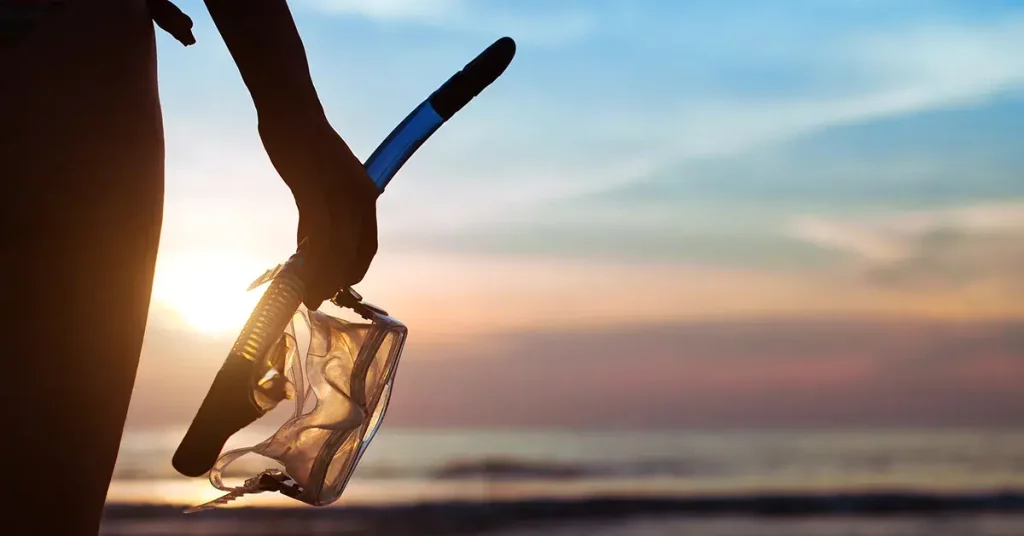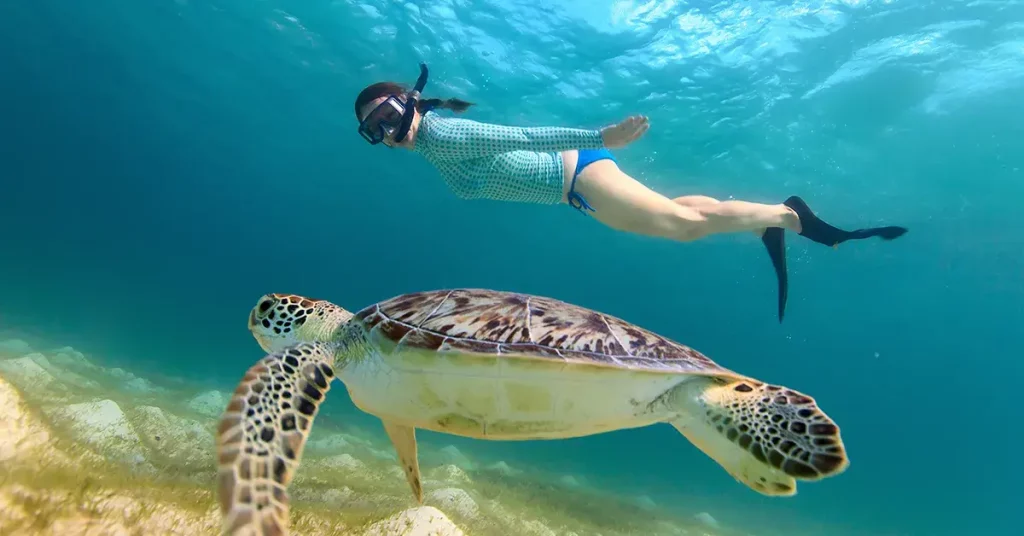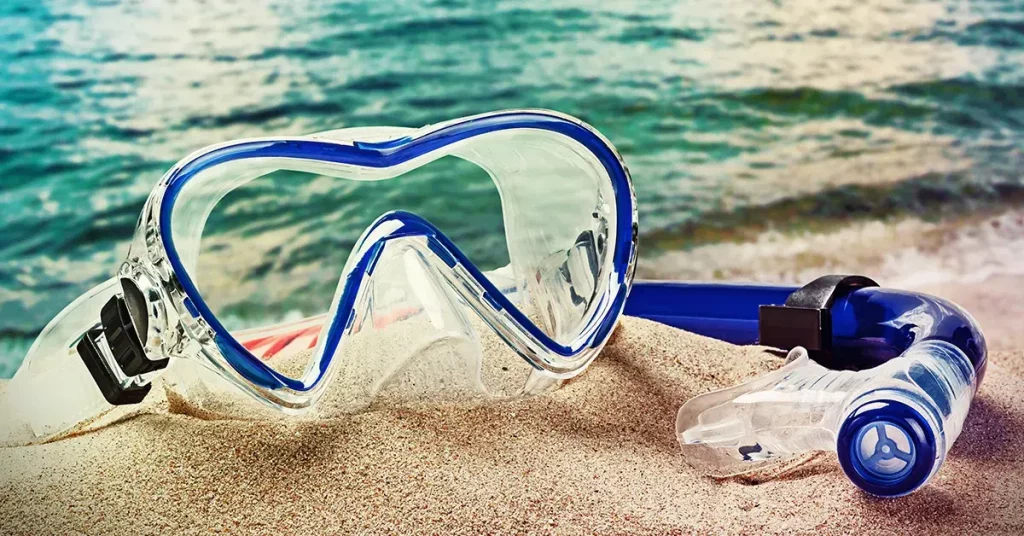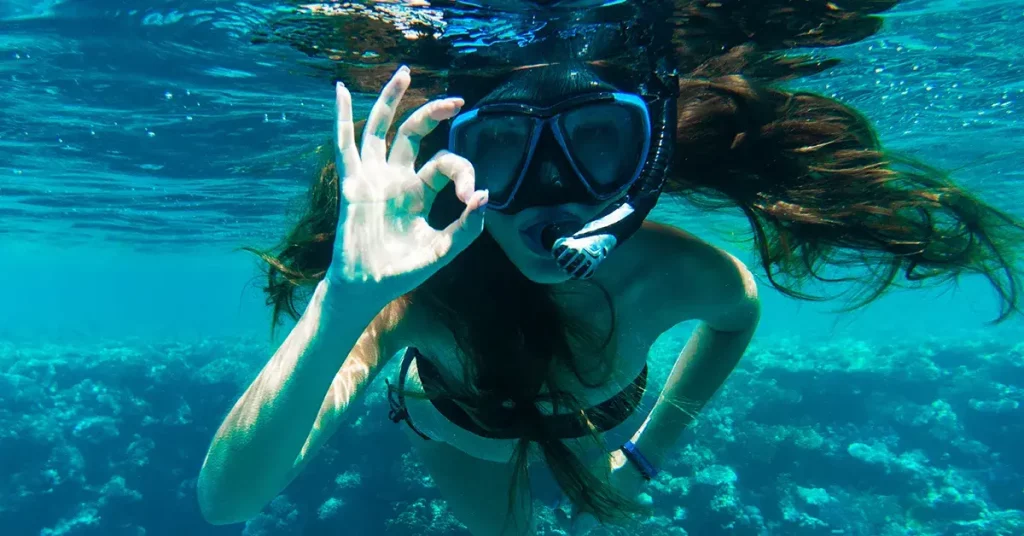Exactly how does snorkeling work? Snorkeling allows you to see what’s below the water’s surface, but unlike scuba diving, it does not need a lot of expensive equipment; all you need is a mask and snorkel. Even non-swimmers can enjoy snorkeling.
If you’ve ever been on a beach trip, you’ve probably seen people snorkeling. But before you go snorkeling, you must learn everything there is to know about this popular watersport and how to operate a snorkel.
A snorkel and a mask are the most basic pieces of snorkeling equipment, as they allow you to observe the undersea world while floating on the water’s surface without having to come up for breath.
You hold one end of the snorkel tube in your mouth, and the top of the tube must protrude above the water’s surface for air exchange to occur. Now, the big question is, how exactly does a snorkel work? Let’s look at how snorkels operate, the variety of available snorkels, and additional snorkeling equipment you might consider utilizing to get the most out of your snorkeling experience.
What is a snorkel?

The snorkel is a flexible tube that allows you to breathe underwater while keeping your face submerged. A snorkel is a little tube that allows you to breathe underwater in layman’s terms. A mouthpiece is on one end, while the other is open to the air. As long as the tube’s top remains above the water, you’ll have a limitless supply of air to breathe while swimming. Plant stems were most likely used to make the first snorkels. With records reaching 500 BCE, the ancient Greeks were the first to use reeds as snorkels.
For durability, most snorkels are now made of plastic or silicone. The tube’s top is solid and waterproof, but the bottom is pliable. This design allows you to change the mouth position as needed and prevent accidental water ingestion.
In most situations, a small reservoir with a purge valve will be located near the mouthpiece. Water will flow here instead of into your mouth if it gets into the snorkel. The valve can force excess water out of the snorkel, leaving enough room for breathing.
So your eyes remain protected, most snorkels come with a mask. Many come with a plastic nose cover to prevent water from entering your nostrils. A built-in clip can assist in keeping your snorkel straight and in place, thus preventing water from entering. Some also have full face snorkel masks.
Types of snorkels

There are 3 types of snorkels. A snorkel could be wet, semi-dry, or dry.
Wet Snorkel
J-style snorkels, J-tube snorkels, and classic snorkels are all examples of wet snorkels. Spear fishers and free divers frequently utilize wet snorkels since they are suited for experienced snorkelers.
If you’re a newbie snorkeler, these traditional snorkels aren’t a good choice because they have the most basic design and don’t have any additional features to help keep the water out of the breathing tube.
Semi-Dry Snorkel
Semi-dry snorkels are the most versatile type of snorkel. They provide comfort and functionality, making them an excellent choice for freedivers and spearfishers who plan to swim underwater.
Scuba divers also use these snorkels to move around on the water’s surface and save air. A splash guard is located at the top of the tube in semi-dry snorkels. This splash guard prevents water from entering the snorkel due to splashes from waves or other swimmers. A purge valve is also included in semi-dry snorkels. The purge valve is positioned at the bottom of the snorkel, making it very easy to get rid of water in the tube.
Dry Snorkel
Both semi-dry and dry snorkels have purge valves and splash guards. However, a dry snorkel includes a float valve. The float valve closes when the breathing tube is entirely immersed, preventing water from entering. Dry snorkels are ideal for beginner snorkelers and snorkeling in waves and should be your first snorkel if you are a newbie.
On the other hand, the float valve traps air in the tube, increasing buoyancy and drag when diving underwater. As a result, dry snorkels aren’t good for scuba divers, freedivers, or spearfishers who spend a lot of time submerged.
How does a snorkel work?

If you’ve never snorkeled before, you’re undoubtedly wondering how a snorkel works. One of the simplest methods to obtain oxygen to your lungs while swimming is to use a snorkel. The waterproof tube allows you to breathe in air -albeit through your mouth- from above the surface even when your face is immersed.
You don’t have to come up for air to enjoy your underwater viewing experience. While using a snorkel, you can dive down for a closer look if the underwater world.
All you have to do is hold your breath. Snorkels, unlike scuba gear, do not actively give oxygen. They allow you to breathe easily above the water’s surface, so you can only stay underwater for as long as you can hold your breath if you dive underwater using a snorkel.
Some snorkel designs include features that make the underwater experience safer and more comfortable. Dry snorkels have a float valve for an airtight seal even when underwater, whereas semi-dry snorkels have a splash guard to protect against splashing waves.
For safety, practically all snorkels feature a reservoir and a purge valve, regardless of design. A reservoir protects you from accidental water aspiration if it gets into your snorkel tube. Rather than blowing out all of the water through the purge valve every time water is in your snorkel, you might let it collect in the reservoir and purge or blow out only when it’s full.
How does a snorkel keep water out?

It can be nerve-wracking to put on your snorkel for the first time. Many novices worry if a snorkel works before plunging into the sea. When worn properly, quality snorkel tubes should not let any water into the main tube. All components should be waterproof and sealed. The mouthpiece should also fit snugly inside your mouth, preventing water from leaking in.
Water should only be able to enter your snorkel from the top of the tube. Unless the tube is designed with an airtight float valve, you will get water inside if you dive under the water. It’s also possible that a strong wave will wash over your snorkel, allowing water to flow inside.
Don’t be alarmed if you get water in your snorkel; it’s bound to happen. That is why the majority of snorkels have a reservoir at the bottom. Surplus water is caught in a tube before it enters your mouth. If water builds up in the reservoir of your snorkel, a strong blast of air will clear it out and make breathing easier, you can practice this in shallow waters.
What other snorkeling gear do you need?

Although not required, you might wish to bring a snorkel vest, fins, and a wet suit.
Snorkel Mask
Snorkel masks allow you to see the wildlife below the water’s surface. It’s important to find one that fits securely so you vision is intact during your snorkeling trip.
Wet Suit
The temperature of the water determines whether or not you require a wetsuit. Wetsuits provide different levels of thermal insulation. Wetsuits are required for snorkeling in colder waters to avoid hypothermia, providing sun protection in milder waters. Jellyfish stings, bruises from jagged rocks and coral reefs, and other marine hazards can all be avoided by wearing a wetsuit.
Fins
Fins allow you to float through the water with little effort. They are beneficial to beginners since they conserve energy and allow you to stay in the water for extended periods without becoming exhausted.
Snorkeling Vests
Snorkeling vests allow you to float and swim in the water while keeping your face submerged. They act like life jackets and any other flotation device you know. A snorkel vest is a wonderful idea for inexperienced swimmers and beginner snorkelers because it keeps the body in the proper position for comfortable and safe snorkeling.
What skills do you need to snorkel?

Snorkeling is possible for non-swimmers; however, knowing how to swim will boost your safety and enjoyment. If you’re planning a snorkeling trip and aren’t a confident swimmer, taking swimming lessons ahead of time may be advantageous.
Deep breathing allows for more efficient air exchange and avoids carbon dioxide build-up. Before jumping into the water, it’s a good idea to get in the habit of taking deep breaths. Breath-hold diving allows you to stay underwater for longer periods, getting much closer to marine life like sea turtles and coral reefs.
Conclusion
Before strapping on their new snorkel, many first-timers ask themselves: How does a snorkel work? Snorkeling offers a fantastic and affordable way to explore underwater on your next getaway by allowing you to breathe underwater. Unlike scuba diving, you don’t need to invest in expensive lessons and bulky equipment.
All you need to try snorkeling is to understand how it works and what skills and equipment are required, all of which we give you in this article. It would be best to be more prepared for a safe and fun snorkeling excursion now that you know the answers to these questions. Finally, keep in mind that mastering snorkeling techniques takes time. Slow down, be patient, and enjoy yourself!




